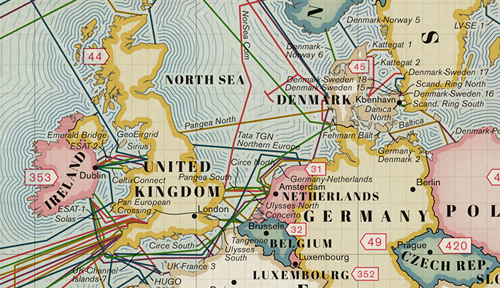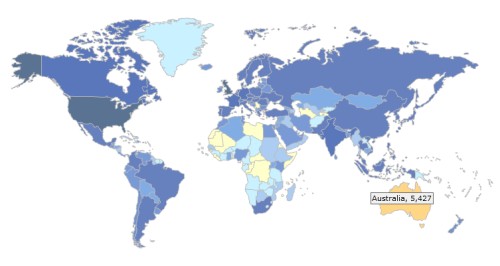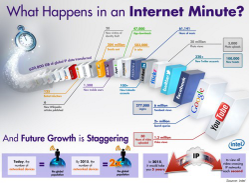Blog posts tagged Internet
Get the right broadband for your business

Comparing broadband packages is like comparing giraffes.
This is a guest post from Anthony Pearce, content manager at BroadbandDeals.co.uk.
Choosing the right broadband package for your business can be a daunting prospect. Although many companies make do with broadband packages designed for residential use, business broadband generally offers a more reliable service with better security.
Here are some key tips to help you find the right broadband package for your business.
1. Check your local broadband exchange
IT dealsSee the latest business tech bargains we've found online. Or buy IT equipment now from these trusted suppliers: |
Your local broadband exchange will determine what business broadband providers are available in your area, and what download speeds you can expect.
Enter your postcode in to the broadband checker at Sam Knows to find a wealth of information about your local broadband exchange and the packages available.
2. Static IP address
Your IP address is a set of numbers that identifies your business internet connection, allowing computers and servers to route data to the right place. Some business packages use dynamic IP addresses.
These can change frequently, so you need a static IP address (which doesn't change) if you want to make it easy for staff to connect to your network from home. Learn more about static and dynamic IP addresses.
3. Advanced security
It's important to think about security when choosing your business broadband. Although most business broadband providers do offer advanced security as standard, make sure it meets your needs, even if that means paying a little extra for additional protection.
4. Online backup
Many broadband providers also offer an online backup service. This can be a good way to back your key files up to remote servers, keeping them safe even if your systems fail.
A broadband package that offers online backup can form a core part of your backup strategy, but always ensure the service is reliable and safe.
5. Virtual private network (VPN)
A virtual private network service helps your staff securely connect to your company network when they're away from the office. It can also allow you to safely link computers and servers in different locations.
A VPN creates a secure 'tunnel' between two computers on the internet, allowing you to safely send data from place to place. You can learn about BT's VPN service here.
6. Compare business broadband deals
There are a number of broadband comparison websites that let you easily compare the latest business broadband deals available in the UK.
One of these websites is BroadbandDeals.co.uk (full disclosure: I work for this site). It has a business section where you can enter your office postcode and see the latest deals in your area.
- How to speed up your broadband connection
- Broadband supplier checklist
- Why does moving a broadband connection take so long?
Free competitive analysis tools for your business
 You can use tools like Google Analytics to see how visitors interact with your website. But that’s just a drop in the ocean in terms of competitive analysis.
You can use tools like Google Analytics to see how visitors interact with your website. But that’s just a drop in the ocean in terms of competitive analysis.
If you’re running a small or new business, there are some excellent, comprehensive and free competitive analysis tools that can provide valuable data to help you understand your market.
Business tech dealsWe scour the web to find you the best business tech bargains. |
You’ll need to be willing to put a bit of time in to learn how to get the most from these free competitive analysis tools. But if you do, you’ll be rewarded with information to help your business succeed.
Competitive analysis for due diligence
You don’t have to pay to view Companies House accounts if you can download them already for free online. That’s where competitive analysis tool Duedil comes in.
Short for ‘due diligence’, it’s an excellent tool that provides free business intelligence such as insight into competitors, suppliers, investors and clients.
You can also use it to benchmark a business’s performance and growth over time, build sales leads and integrate social networks such as LinkedIn.
Competitive analysis tools beyond Google
Google Analytics and Google Trends are good free competitive analysis tools because they’re integrated with the most popular search engine in the world. It means you get data ‘right from the horse’s mouth’.
But it’s a good idea to go beyond Google to get deeper insight into your website’s analytics. Comparing data sets can help you avoid sample biases that come about from opt-in panels or toolbars, giving you a more accurate picture of how your audience is behaving in response to your marketing efforts.
For example, have a look at the free competitive analysis tools from SEOmoz.
Using Facebook for competitive analysis
Search engines are constantly learning more about how people categorise and search for information. A big part of the mix in recent years has been social media, which search engines now indirectly recognise and attribute authority to.
In other words, it’s important to use and understand social media to reach your audience, and watch and learn from competitors too.
Anaylse your social media efforts using tools like FeedCompare, HootSuite, SocialMention and Google Alerts.
Competitive analysis doesn’t need to be expensive and complicated. As long as you’re willing to work at it, you can get valuable insight on your partners, suppliers, clients and customers … and get a step ahead in your business.
- How democratising data can benefit your business
- Business benefits of web analytics
- Coping with growing data storage needs
Helen Major has a keen interest in finance and has been writing for blogs and newspapers on the subject since she graduated from the University of Edinburgh in 2007. She is currently writing on behalf of Duedil, a free Company House and directors’ search database.
Are you ready for mobile commerce?
 Accessing the internet on mobile phones has been one of the fastest growing technology trends over the last few years. UK consumers have rushed to buy smart phones, with ownership almost doubling in the past couple of years.
Accessing the internet on mobile phones has been one of the fastest growing technology trends over the last few years. UK consumers have rushed to buy smart phones, with ownership almost doubling in the past couple of years.
As a result, businesses really need to wise up to the evolving mobile website landscape.
Mobile commerce leaves companies behind
Worryingly, smaller UK businesses are falling behind in this mobile world, missing out on vital sales and new customers.
‘Digital Dinosaurs’ research conducted by BaseKit (the company I work for) shows just 9% of businesses say their websites can be used with mobile phones and tablets.
The same research found 45% of internet users use a mobile device to access the web and that 6% have shopped online from their mobile phone. This means people are spending up to £1.3 billion via ‘on the move’ purchases.
This confirms the shift to mobile is being led by consumers, which means it’s vital businesses reconsider their mobile internet presence.
Mobile commerce grows fast
The risk businesses are facing is that they’ll miss out on mobile custom. Many believe creating a mobile-friendly site is too costly or complicated.
However, with reports predicting purchases made using smart phones could make up 12% of all ecommerce, smaller companies can’t afford to ignore the mobile trend. There are a number of options available to create mobile websites – not all of them complicated - and they can ensure mobile visitors have a good website experience.
Half a million aren’t online
Our report also found that, while vast numbers of the UK’s 1.1 million small businesses (1 – 49 employees, 2011 Government figure) are online, there are still 660,000 that have yet to get themselves online at all.
Even those companies that have got to grips with the web are risking falling behind by not creating sites that can be used on mobile phones.
Perhaps most notably, we found that businesses really do worry about falling behind the pace of technology change. Half say they are ‘concerned’ or ‘very concerned’ that they are being overtaken by changes including the advance of mobile internet usage.
Quite simply, it’s time smaller companies invested in becoming fully accessible to customers using mobile internet. If they don’t, the risk of losing out on future custom is very real.
- A mobile website can net you more customers
- Mobile apps vs. mobile websites
- How to optimise your website for smart phones
Ramandeep Sambi is an online marketing executive at BaseKit.
Did we just nearly break the internet? What the Spamhaus attack says about our security
 If you noticed your internet connection slowing markedly yesterday, with some sites sluggish and others unavailable, for once it might not have been down to your broadband supplier.
If you noticed your internet connection slowing markedly yesterday, with some sites sluggish and others unavailable, for once it might not have been down to your broadband supplier.
That's because spam fighting service Spamhaus was subjected to an enormous distributed denial of service (DDoS) attack.
It seems that Spamhaus blacklisted a controversial hosting provider, Cyberbunker, because its servers were apparently being used to send lots of spam. 'Friends' of Cyberbunker then bombarded Spamhaus with the biggest DDoS attack ever.
Are any of us innocent?
The incident spawned headlines like Global internet slows after 'biggest attack in history'. And with so much malicious data flying through the internet's wires, some innocent internet users found their service was disrupted as a result.
But how innocent are those internet users? Is our slack security as individuals partly to blame for the scale of the disruption?
It's an interesting question because this attack was coordinated using a huge 'botnet' of internet devices, including a large number of insecure broadband routers.
It's the exact threat experts recently warned us about, where hackers exploit weaknesses like default passwords to take control of these devices.
Looking for a deal?See the latest business tech bargains we've found online. Or buy IT equpment now from these trusted suppliers: |
Your router is part of the problem
As more details of the Spamhaus attack emerge, we might get a better idea of what devices it involved. But as The Guardian reports, that innocent-looking router in the corner of your office could have been a part of the problem:
"Some of those requests will have been coming from UK users without their knowledge, said Blessing [an internet expert]. "If somebody has a badly configured broadband modem or router, anybody in the outside world can use it to redirect traffic and attack the target – in this case, Spamhaus."
Obviously, whoever initiated the attack is ultimately responsible. However, the scale of it was partly due to the vast number of insecure internet devices out there.
We're all to blame
So, who is to blame? Manufacturers who sell their products with inadequate security and don't properly explain how to beef it up? Internet service providers that make their routers less secure so they can log in remotely when they need to? IT adminstrators who don't update their software promptly?
Or is it all of them, and each of us too?
The internet is a decentralised, open network. That makes it very difficult for any single body to effectively police this type of incident, and means that we're collectively responsible for the internet's security.
Yesterday, we almost broke it. Perhaps it's time we all took the time to be more secure online.
How undersea journeys hold the internet together
If you have a few moments to spare this morning and a burning desire to learn more about how data travels to your computer from servers around the world, take a look at this map. It shows the vital underwater cables that connect continents and carry the vast majority of the world's internet traffic.

Whenever you visit a website that's located on a server in another part of the world, it's almost certain that the data from that server will reach your computer by travelling through some of these undersea cables.
It's incredible to think that these tiny cables - each usually less than 10cm in diameter - form such a vital part of the internet infrastructure we've come to rely on every day. With each carrying an enormous volume of data, it's no wonder that a single cable snapping can cause big disruption and hit the headlines.
See the full map here >>
So, next time you watch that video of a panda sneezing on YouTube, just think how far it might have travelled to reach you. The internet: isn't it amazing?
- An amazing map of the internet
- What happens in an internet minute
- Internet speed checker - test your connection
Are we getting close to broadband Britain yet?
 A new report into the state of UK broadband was released this week by independent think tank The Policy Exchange. By giving it the title of The Superfast and the Furious, they've already elevated it above many official reports.
A new report into the state of UK broadband was released this week by independent think tank The Policy Exchange. By giving it the title of The Superfast and the Furious, they've already elevated it above many official reports.
What's more, its findings make interesting reading.
Availability or speed?
The report throws up an interesting contrast between the broadband priorities of businesses and those of individuals.
Of businesses questioned, 61% said they felt providing high broadband speeds in most (but not all) areas should be prioritised over ensuring basic broadband is available everywhere.
But when consumers were asked a similar question, 64% said that achieving good basic broadband coverage for the whole country is more important than chasing very fast speeds in some areas at the expense of others.
Can't we have both?
This dilemma seems to arise whenever the spectre of 'broadband Britain' hits the headlines. When culture secretary Jeremy Hunt pledged that the UK would have Europe's fastest broadband by 2015, the opposition's response was that this meant "millions of people will have to wait at least three more years for a broadband connection".
But isn't the choice something of a red herring? Doesn't the country that generates more money online than any other G20 nation deserve 100% coverage of superfast broadband?
Some way to go
While policy experts debate how best to spend the money allocated to our broadband infrastructure, things on the ground are still confusing. Back in September, research found only 34% of broadband users actually get the maximum speed that was advertised for their particular package.
What's more, a recent poll by broadband review site ISPreview found that a massive 42% of respondents are 'unhappy' with their current internet service provider (ISP).
Ok, that's a small improvement on when ISPreview asked the same question a year ago (44% of respondents were 'unhappy'), but it's still a long way from broadband nirvana, when we will all have super-reliable, superfast connections.
The internet contributes to over 8% of the UK economy, and the continued success of online businesses of all kinds is going to be vital if we are to see a return to strong growth in the coming years.
Affordable, reliable, fast internet connections are central to achieving that - so it's about time individuals and businesses in every part of the country were able to access the high-speed connections they deserve.
How's your internet connection? Could you do more with more speed?
- UK broadband still not good enough
- Why does moving a broadband connection take so long?
- Why your internet connection is slower than you'd hoped
(Image: Elliott Brown on Flickr.)
Could you survive a denial of service attack?
Distributed denial of service attack. DDoS for short. Four letters that are can strike terror into the heart of anyone who's been on the receiving end of one.
Overwhelming a website
DDoS attacks aim to take websites offline by overwhelming them with requests for information. Typically, they involve hundreds or thousands of computers, all coordinated to bombard the site simultaneously.
Often, the owners of these computers don't even know what's going on, because the source of the attack is malware that's infected their machines.
DDoS attacks have hit the news regularly in 2012. Last month, Teresa May and the Home Office were targeted. Back in May, Webfusion - one of the UK's largest web hosts - was on the receiving end of a sustained attack (the firm produced an interesting white paper explaining what happened).
Other victims have included Virgin Media, WikiLeaks, HSBC and Amazon.
DDoS - not just big brands
The motives for DDoS attacks vary. Sometimes they're random. Sometimes they're political. But there's often a financial aspect. They can come from your competitors, or they can be blackmail, pure and simple. Pay up, or your website stays offline.
And although it's only big name brands that hit the news, online criminals are increasingly turning their attention to smaller companies. Without the resources to deflect attacks, they're softer targets.
As security expert Don Smith told us recently:
"More and more smaller companies are being attacked by cyber criminals, yet many still hold the view that they are too small to be targeted."
Web hosting and DDoS
If you're not prepared, combating a DDoS attack can be tricky. When your website's overwhelmed by spurious traffic, you may find you're unable to even log in yourself.
In fact, the possibility of a DDoS attack is something you should consider when choosing a web host, because the way they handle them can vary remarkably.
Get the right hosting
Some hosting companies will simply take your website offline completely so that their other customers aren't affected. Worse, you might get a bill for the extra traffic the attack generated.
Other web hosts will provide far more constructive assistance. Ask if they can give you examples of how they've fended off attacks in the past, and look for security features that come as part of your package, like DDoS protection.
Also make sure they keep their servers and apps up-to-date, because often the latest versions of ecommerce and content management tools are more resistant to DDoS attacks.
Looking for a new web hosting firm?Here are some firms you might like to consider: |
Have you ever suffered a DDoS attack? How did you cope?
Mobile commerce: what you need to know
 Between summer 2011 and summer 2012, traffic to ecommerce sites from smart phones and tablets grew by up to 200%. Warren Knight, CEO and co-founder of social sharing and ecommerce platform Gloople, explains why mobile commerce is becoming more important every day.
Between summer 2011 and summer 2012, traffic to ecommerce sites from smart phones and tablets grew by up to 200%. Warren Knight, CEO and co-founder of social sharing and ecommerce platform Gloople, explains why mobile commerce is becoming more important every day.
Catering for mobile shoppers
I was recently with a new client who sells men's clothing. The first thing I helped them with was to understand their online customers through Google Analytics. To their surprise, not only had they seen a massive increase in mobile and tablet visitors and customers, but mobile customers were spending 10% more than other customers.
This is definitely not an anomaly. It's something I've seen time and time again. It's time to pay attention.
The big turnoff
The biggest turnoff for mobile shoppers is the difficult customer acquisition journey. This is the step by step process a website visitor goes through in order to purchase a product.
Some online stores lose sales because their website is either archaic or non-responsive, meaning that the journey of purchasing a product is intolerable. The result is that visitors leave the website without purchasing anything.
To solve this problem you can either build a responsive website design or create a mobile app.
Changing purchase habits
The way people purchase goods has changed since the days of going to a store and paying cash for it. Don’t get me wrong - in-store shopping is still leading in sales. However, most people will no longer drive hours to a shop just to find that what they want no longer exists.
There's been a big shift towards online shopping, and mobile commerce is the next logical progression. Indeed, eBay alone has 300 - 400 employees working on mobile solutions, with the company expecting to rack up mobile sales worth $10bn in 2012.
Mobile devices are becoming a central part of our lives and should be used as tools to help us shop and pay. With most mobile phones now coming with either 3G, 4G or the ability to connect via a wireless network, there is no excuse in avoiding the inevitable. Mobile commerce is the future.
Why websites load slowly, and why it matters
How long does your website take to load? Two seconds? Ten seconds? 30 seconds or more? If you've never paid attention to your site's load speed, perhaps you should. It can affect how often people return and influence your rankings on Google.
In short, web page loading times matter. But a whole variety of factors influence how long your homepage actually takes to appear on a visitor's screen.
This infographic shows you the major causes of slow loading sites. How does your site measure up?
TOTW: make sure your online shop is legal

Is your online shop causing customers problems? (Image: wonderferret on Flickr.)
The Office of Fair Trading (OFT) recently performed a 'websweep' exercise (a pleasingly retro-sounding term which reminds me a little of the days when we user to 'surf' the internet). This saw the watchdog review the UK's top 100 online retailers to check they are complying with their legal obligations, particularly those relating to distance selling.
Its results were mixed. Overall, around two-thirds of businesses weren't complying with all the legal requirements. However, problems were really grouped in three key areas.
So, for this week's tip of the week we thought we'd give you those three key things, so you can check them on your ecommerce website. They'll help make sure you're legally compliant, and give your customers the information they need to buy with confidence:
- Make sure you have a real-world address. The regulations say you need to provide your postal address if you ask for payment in advance. Make sure this is the real location of your business, not a PO Box. Make this easy to find by putting it on your 'contact' page or including it in your website footer.
- Provide an email address so people can contact you. Only 38% of sites checked provided an email address, even though ecommerce regulations say you must show one somewhere. Many websites rely on just a contact form, which is not enough. (Contact forms can also be prone to failure, so email is a good backup.)
- Be upfront about all extra charges. The OFT found that 60% of websites added extra charges which weren't clear from the outset. These were usually delivery charges. It's best to price your items with delivery included, or provide a clear 'plus delivery' label on prices.
If your online shop is built using an ecommerce system, it should be relatively straightforward to make these changes without delving into your website's HTML code.
You can read the OFT's full report here (PDF). Do any of these requirements come as a surprise to you? Leave a comment and let us know.
Should you move to a data centre?
 Your business needs to maintain a reliable backup of digital data, like your customer database, documents, images, emails, accounts and so on.
Your business needs to maintain a reliable backup of digital data, like your customer database, documents, images, emails, accounts and so on.
That data is mission critical, so it all has to be kept safe from theft, fire, flood or accidental deletion. If you run a smaller company, it’s likely your data is stored on a simple server in the office.
What happens as your business grows?
As demand grows for your company’s products or services, you’ll collect more data. As a result, you inevitably end up needing more than a single server. Eventually, you end up with a whole room of the things. This brings new demands and costs:
- You need air conditioning, because lots of servers create lots of heat. If you don’t keep them cool they can fail catastrophically. Providing cooling using traditional air-conditioning units can be very expensive.
- You need an IT professional to make sure your servers keep running reliably. For 24/7 cover you’ll probably need more than one person.
These requirements can become a major financial, logistical and security headache.
Moving to a data centre
A common solution to these problems is to use a purpose-built data centre. Maintained by network specialists, mechanical experts and electrical engineers, a data centre is a secure, computer-friendly environment run at the perfect temperature for the servers inside.
From a security perspective, data centres are also equipped with their own backup power supply. This is usually an uninterruptable power supply (UPS), a large bank of batteries plus a generator to ensure power is always available.
Data centres also usually have direct connections into major internet links – also called the ‘internet backbone’ – meaning connectivity is fast and reliable.
Businesses usually put their servers into a data centre that’s shared with other organisations. This is known as colocation.
What does a data centre look like?
The image above is of a typical data centre. They have lots of aisles between servers stacked in locked cabinets (called racks). You rent as many racks as you want and you pay according to the amount of processing power, storage space or bandwidth you use.
Many providers off both DIY and full service maintenance options, so you can maintain systems yourself or use the provider’s technical support.
There are a number of good arguments for using a data centre:
- Data can be backed up easily and securely
- The risk of data loss is significantly reduced
- Internet access is fast and reliable
- The data centre provides support round-the-clock
- Your overheads are reduced
Using a data centre also makes it easy to add extra capacity as your business grows (you just rent more space) and you don’t have to worry about having lots of servers on your premises.
- Is IT the fifth utility?
- Can the cloud make you more efficient?
- Six signs your business needs a server
David Barker is technical director and founder of 4D Data Centres, the green colocation and connectivity supplier.
The seven layers that power the internet
Computer networks are complex things. But if you want to get beyond the ‘I plug it in and it works’ stage, it’s worth knowing a little about the Seven Layer OSI Model. It’s always good to have a bit of basic knowledge when dealing with IT suppliers too.
The Seven Layer OSI Model was created in the 1970s as an open standard for all networks and applications that exchange data. Since then, technology has changed a lot, so you will find that many books and articles on the subject contradict each other to some extent.
These days, it’s common for some of the layers to be blended together, but the principles of the Seven Layer Model do still stand.
How the Seven Layer OSI Model works
You can think of the seven layers in the Model as different stages of a production line. At each stage, something is done to the data passing through the network that gets it ready for the next. The seven layers are:
- Application layer: interacts with your software to send or receive data.
- Presentation layer: converts data into a standard format.
- Session layer: starts, maintains and stops network communication.
- Transport layer: makes sure all data reaches the right destination.
- Network layer: routes data to the correct place.
- Data layer: defines which how the data will be transmitted.
- Physical layer: the network cables and signals that pass down them.
Why do we need the OSI Model?
The OSI model is one of those important things that sits behind everything on any network. It provides a structure so the internet can function. Without the OSI model it would have been nearly impossible to connect networks together. We just wouldn’t have the internet as we know it today.
It aims to break down all network communications into smaller elements that are easier to create standards around. With these standards in place any IT developer - especially those involved in networking – can work to the same framework.
This means that a developer working for Facebook doesn’t need to know how the physical network cabling is laid, nor how an ISP routes its data. As long as everything sticks to the OSI Model’s standards, it’ll work fine.
- Read more about the seven layers in the 4D Data Centres whitepaper: The OSI Network Layer Model Explained.
David Barker is technical director and founder of 4D Data Centres, the green colocation and connectivity supplier.
UK broadband: still not good enough

How fast is your broadband? (Image: krossbow on Flickr)
Come on coalition, pull your fingers out and get us the broadband we need. That could be the message to take from a recent ISPreview.co.uk poll, which found that of 1,600 broadband users questioned, only 34% actually received their desired internet connection speed.
Yes, that is the reality of the 'broadband Britain' we live in today. Most internet connections still rely on shonky old copper telephone wires, a technology which has been around since Alexander Graham Bell invented the dog and bone. As a result, we're stuck with connections that regularly fail to meet our expectations.
Broadband frustrations
Just to muddy the waters further, internet service providers frequently use best-case connection speeds in their advertising, even though most people don't have the slightest hope of ever achieving them.
It's no wonder we get frustrated. And that's before you bring the government into the picture. It has set a target minimum connection speed of 2Mbps (megabits per second), saying everyone in the country should be able to achieve it by 2015.
But to put things into perspective, the average connection speed in Latvia is 8.8Mbps. In South Korea it's over 15Mbps. (Source: Akamai State of the Internet.)
What's more, only 4.7% of the poll respondents said that 2Mbps was adequate for their needs. As Mark Jackson, founder of ISPreview.co.uk, explains: "Clearly 2Mbps isn't enough with only 4.7% of respondents claiming to need such a speed and everybody else wanting something far faster."
Perhaps the EU's Digital Agenda for Europe is more realistic. It wants 100% of people to have access to broadband at 30Mbps or above, but not till 2020.
Broadband bright spots
Although much of the UK still isn't getting the broadband it deserves, there are some bright spots. BT continues to roll out its Infinity service. Business packages start from £30 a month and include a prioritised service so your connection doesn't suffer at peak times. Its biggest competitor is Virgin Media, which offers its 60Mbps service for under £30 a month.
Both these services are good deals and should seriously outperform any broadband connection based on old-fashioned ADSL technology. But - of course - they're only available if your business is based in an area these providers cover. And that's the sticking point for many companies, particularly those based in more rural locations.
Is your broadband connection adequate? Do you pay through the nose for it? Leave a comment and let us know.
.co domain names: not just a load of hype?

Just over two years ago, it became easy for anyone to register and own a domain name ending in .co. This meant you could have www.yourbusiness.co as your website address.
The .co mascot appears to be a flying pig (see image), which seemed suitable - because at the time, we were we were sceptical. Who'd want a .co domain name? It just looks like you've missed the .uk off the end of it.
A couple of years later, I'm starting to wonder if we called it wrong. Seeing a .co domain name on a business card or sign still looks weird to me, but the fact I've been noticing them 'in the wild' at all suggests they are gaining in popularity.
Is .co more recognisable?
Of course, the more companies that use them, the more recognisable .co domain names will become. That means even more businesses will starting using them, which means ... well, it means that if you have your eyes on a good .co domain name, you might want to grab it sooner rather than later.
Aside from Joan Rivers - whose website, joan.co, is proudly cited by the official .co registry - I've noticed a few small businesses using .co domains in the last few weeks:
- The Gardener's Cottage, a small restaurant in Edinburgh at www.thegardenerscottage.co
- Food for Thought, a London catering firm that has snaffled www.foodforthought.co
- Decoded, a firm offering a one-day computing coding workshop via www.decoded.co
- XOXO, a too-cool-for-school London bar you'll find at www.xoxolondon.co
Sure - it's still early days for .co domains, and they're a long way off from becoming mainstream. But I just wonder: if these pioneering companies do mark the start of the trend, now would be the right time to grab a decent .co domain name for your new business, or for that business idea you'd like to get off the ground one day.
How to register a .co domain
Most domain name registration companies offer .co domain names, although prices can vary quite a lot. Here are some of the best options out there at the moment:
- 123-reg has .co domain names at £14.99 for the first year, rising to £29.99 for subsequent years.
- GoDaddy has .co domains at £18.89 a year, with £10 off for the first year.
- Easily has .co domains for £24.99 a year.
- 1and1 has .co domains for £29.99 a year.
As with most other domain names, you must buy your domain for a minimum of a year. You can then choose to renew if you want to. If you buy a domain with any of the companies listed above then it should be relatively straightforward to use it however you wish in future: to set up a website, for email addresses, and so on.
What do you think of .co domains? Are they a worthwhile investment, or a waste of money?
Why your business needs IPv6
 One of the internet’s fundamental technologies is changing. David Barker, founder and technical director of 4D Data Centres explains IPv6 and why your business should be deploying it.
One of the internet’s fundamental technologies is changing. David Barker, founder and technical director of 4D Data Centres explains IPv6 and why your business should be deploying it.
IP stands for internet protocol. It’s a key part of the technology that enables most internet-connected computers to communicate.
An IP address is the unique label given to every device connected to a network (or to the internet). In the same way that your home address enables letters to reach you, an IP address enables devices on a network to send data to each other. An IP address looks something like this: 192.168.12.4.
From IPv4 to IPv6
IPv4 is (unsurprisingly) the fourth revision of the internet protocol and the most widely used today. However, it is also fairly old - it was originally ratified in 1981.
In total IPv4 has capacity for 4,200,000,000 unique IP addresses. Back in 1981 they assumed that would be enough to cover any possible eventuality. It’s lasted three decades, but there are now so many devices in the world that need to connect to the internet (each requiring its own, unique address) that we’re running out of room.
Step forward IPv6 (IPv5 was an experiment). It provides a massive increase in the number of addresses available. This means an IPv6 address looks very different to an IPv4 address – usually something like: 2001:cdba:0000:0000:0000:0000:3257:9652. Sometimes all zeros are omitted to save space, leaving a colon marking the gap: 2001:cdba::3257:9652.
IPv6 was designed from the ground-up to allow for an enormous number of IP addresses. There are enough for computers and mobile phones and household appliances and cars.
In total it provides roughly 340,000,000,000,000,000,000,000,000,000,000,000,000 unique addresses. To put it into perspective, that’s 480,000,000,000,000,000,000,000,000,000 addresses for each of the seven billion people on the planet.
Should you worry about IPv6?
It’s vital your business starts thinking about IPv6 sooner rather than later. If you don’t introduce it to your network then over the next few years there will be parts of the internet that you simply won’t be able to access.
Once we’ve completely run out of IPv4 addresses, companies will be forced to deploy new services as IPv6-only. This is already starting to happen in Asia. For instance, operators in countries such as China are running on IPv6-only as they don’t have enough IPv4 addresses to support the number of people going online.
What’s more, if you introduce IPv6 early, you’ll have more time to learn how to make use of new features that IPv6 includes. A lot of these are technical features to improve data routing and security but there may also be ways to make money from IPv6. Perhaps you can take advantage of new services, or drive your own markets by showing your customers that you are an early adopter.
What you can do next
After reading this article you should know that IPv6 exists and it’s important you adopt it sooner rather than later – that’s a good start!
Now, here are four more steps to help your business get ready:
- Start by testing your existing internet connection to see if it is IPv6-enabled. You can do this easily online, right now. This website is especially helpful because it will tell you how prepared your internet service provider (ISP) is for IPv6. You can use the test results when talking to your ISP about its plans for IPv6.
- Make sure that your office network will run on IPv6. Firewalls are the key here as IPv6 support on firewalls has been fairly limited until recently. Your PC and ISP might be IPv6-enabled but if the firewall only talks IPv4 it will need replacing. It’s worth raising this with your IT supplier now, so you can budget for changes if required.
- Make sure your website (plus any other public servers) are running on IPv6 as well as IPv4. Over time, devices will begin to only support IPv6. You don’t want your website to drop off the internet as this happens. Your web hosting company should be able to advise.
Has your IT supplier mentioned IPv6? Is this the first you’ve heard of it? Leave a comment to let us know.
- For more information about IPv6 and how to switch, download 4D Data Centre’s white paper: IPv6: A Primer.
- The internet is running out of room
An amazing map of the internet

Stuck for something to do this morning in that brief period between the end of breakfast and the start of the athletics? We've just stumbled across this jaw-dropping, fascinating internet map.
It shows 350,000 websites, each represented as a dot. The size of each dot is determined by the amount of traffic that website receives, and dots are grouped together in a way that mirrors how closely sites are linked. The map uses figures from the end of last year - at the highest level, you can see how sites like Google, Facebook and YouTube dominate.
But as you zoom in, extra levels of detail become visible, revealing corners of the internet and sites you'd forgotten all about. You can even search for websites to see where they sit in the map and how big they are in comparison to websites around them.
Visit the internet map at www.internet-map.net.
Coming soon: dodgy domains and useless URLs
 Good grief. The world of domain names looks like it’s about to become much more confusing.
Good grief. The world of domain names looks like it’s about to become much more confusing.
You might remember that about a year ago, ICANN (the organisation that manages domain names around the world) decided that we needed some new domain name extensions to go along with .com, .co.uk and the like. It wanted to pave the way for domain names ending in things like .microsoft, .google, .web or .anythingatall.
Sounds confusing? That’s because it is. There’s already a bewildering array of domain names available out there, from .co and .biz to .info and .xxx. You rarely see companies using them because most businesses realise that a .com or .co.uk is their best bet.
Sure, it’s irritating that professional domain name traders have bought up lots of the best addresses. In fact, you could argue that’s played a part in creating false demand for new domain extensions.
But no matter. It’s happening. New domain extensions are coming soon. There have been over 1,900 applications for the things, mainly driven by big businesses who see a branding opportunity (.amazon, anyone?) and investors who see an opportunity to profit.
The full list of possible new extensions was released recently. Here are a few that caught my eye:
- .bbc. Our world-renowned British Broadcasting Corporation has applied for this one. After all, bbc.co.uk is such a tricky address to recall and type in a hurry.
- .porn, .sex, .sexy and .adult. Oh come on, it is the internet – you must have been expecting some adult-themed domains. But wasn’t .xxx supposed to be the definitive adult domain name?
- .cymru, .wales and .scot. If you run a business in Wales or Scotland, would one of these domains interest you? There are no domains proposed for England or Northern Ireland, as far as I can see.
- .rip and .vip. Two interesting target markets: dead people and people who think they’re more important than the rest of us. I can’t see us bothering with itdonut.rip, if I’m honest.
- .app. As mobile apps have become the thing in the last couple of years, is it any surprise that 13 different bidders are vying to run this domain extension? (Perhaps surprisingly, Apple doesn’t appear to be one of them.)
- .bentley, .boots, .guardian, .sky and .nextdirect. These are just some of the big UK brands which have decided they want to take a punt on their own domain extension. But is .nextdirect really any better than next.co.uk?
If you can be bothered then you too can review the whole list of proposed domains. Make sure you look out for my personal favourite: .transformers, which Hasbro has proposed. In fact, that’s maybe the only worthwhile one of the lot.
Shopping around for a new domain name?
Or looking for a web hosting company? You can buy domains and web hosting from: 123-reg; Daily Hosting; NamesCo; Easily; 1and1; JustHost; Heart Internet; Strato Hosting; eUK Host; UK2.net.
More content on domain names:
Friday Donut tip: selectively delete cookies
 When you’re making changes to your website, generally browsing, or are having trouble with something stuck in your shopping cart – there’ll come a time when you want to delete some cookies. You can delete your entire history, which will also delete all of your cookies – but sometimes you might want to be a bit more selective about what you delete.
When you’re making changes to your website, generally browsing, or are having trouble with something stuck in your shopping cart – there’ll come a time when you want to delete some cookies. You can delete your entire history, which will also delete all of your cookies – but sometimes you might want to be a bit more selective about what you delete.
Here we cover how to do just that in the top 3 browsers:
Chrome
Click the spanner icon in the top right
Click ‘settings’
Click ‘Show advanced settings’ (at the bottom)
Click ‘Content settings’
Click ‘All cookies and site data’
Search for the domain name of the website in the top right
Click the X alongside each cookie you want to remove
Firefox
Click ‘Tools’ then ‘Options’
Select ‘Privacy’ along the top
Select ‘Remove individual cookies’
Search for the domain of the website
Select a cookie and click ‘Remove cookie’
Internet Explorer
Click ‘Tools’ then ‘Internet options’
Click ‘Settings’ under ‘Browsing history’ on the ‘General’ tab
Click ‘View files’ under ‘Temporary internet files’
Using the standard Windows search feature, search for the domain of the website
Select the cookies you want to remove and press delete on your keyboard (or right click and select delete)
You’ll need to refresh the page in all of these browsers in order to see any changes having removed the cookie.
Bonus joke: A website asked me if I minded if they store some cookies on my machine. I said that I do. They then asked if I wanted them to remember that preference – which would involve storing a cookie on my machine. Tough one.
How the cookie law affects email marketing
 The much-maligned new EU cookie law isn’t just about cookies. Actually, the text of the regulation doesn’t even mention cookies by name. Instead, its focus is on making people more aware of how their information is used online, and helping people control their privacy.
The much-maligned new EU cookie law isn’t just about cookies. Actually, the text of the regulation doesn’t even mention cookies by name. Instead, its focus is on making people more aware of how their information is used online, and helping people control their privacy.
Essentially it means people now have to actively opt-in before their information is used or their behaviour is tracked in many ways.
The new regulation also applies to other technologies that involve you placing and accessing information on someone’s computer. For instance, the new rules apply to the tiny ‘web beacons’ (actually small image files) used to track when a marketing email is opened.
Some criticism has been levelled at the Information Commissioner’s Office (ICO) for not issuing clear guidance. But actually, to understand what’s expected of companies, we need to step back from the nuts and bolts and look at what the law is trying to achieve.
One that front, the ICO’s message has been consistent: businesses need to be open and transparent, because the law is intended to protect privacy and promote openness.
The new law and email marketing
Plenty has already been said about how the new law affects website cookies. (Read the IT Donut guide, if you need help). So I’m going to look at what happens if your business sends marketing messages by email.
If your company falls into that category, you probably track how people interact with your messages. Crucially, you probably have a tool that lets you see how many people open the emails you send.
Just as with cookies, you need to ask a key question about this ‘open tracking’: what’s its purpose? Just as all cookies aren’t equal, neither is all open tracking.
If you’re using open tracking to report an overall open rate for your entire email campaign, I don’t see how this can come under the new law. It’s just a broad way of tracking how people are interacting with your emails.
Would your email subscribers be surprised to know that you work to get emails delivered and monitor success by checking if the emails are read? I think not. And that’s why I think tracking mechanisms used in this way would fall outside the law.
The law applies when the data gets personal
But here’s a different theoretical case. Say a travel company spots that someone opens emails related to family holidays, then sells that information to a company which then targets them with adverts for child investment products.
This sort of open tracking would certainly fall within the regulations as it clearly involves the privacy of the individual. (I’m just using this example to make the point clear - I don’t actually think anyone does anything even close to this with open tracking!)
Getting new subscribers to opt-in
Having said that, the new law is about openness and transparency. So to be safe, it’s a good idea to keep your email subscribers informed about the tracking you use.
It should be relatively easy to ask new subscribers to opt-in to tracking and cookies. You have to get permission to send them emails anyway, so when you do so just add information about the tracking too.
Remember: openness and transparency are key. So don’t bury the information deep in a policy privacy policy or write it using confusing language. Make it clear and obvious, and reinforce it in your welcome email. For example:
We work hard to avoid cluttering up your inbox by using technology to understand what we should send you. Read how here.
Then, no matter whether you think open tracking is or isn’t covered by the regulations, you’ll know you’re covered. And your customers will be better informed too.
Making sure current subscribers know the score
With new subscribers taken care of, think about what to do your current subscriber base. You need to ask two questions: how do you use open tracking and what would your subscribers reasonably expect you to be doing?
Again, it’s about openness and transparency. You can make current subscribers aware of your use of tracking. Add information about it to your email header. Use the same language you use for new subscribers and keep the information there until it’s reasonable to assume everyone’s seen it. Then you can move it to your email footer.
Don’t panic about your open tracking
In any case, if you have worked to promote openness and transparency you will be in a much better position with the ICO than if you have simply ignored this issue. In short:
- Tell new email subscribers what tracking technology you used. Explain it in simple, clear language that can be easily understood.
- Make sure you include this information if you have a soft opt-in – like when you sign people up as part of a purchasing process on your website.
- Change your privacy policy so people who opt in to emails are also opting in to your open tracking and cookie-based tracking.
- Provide a clear link to your full privacy policy as part of the sign up process, and add a summary to any welcome emails you send out.
- Tell your current subscribers about tracking through an email header. You can move this to the footer once it’s reasonable to think most people will have seen it.
Finally, don’t panic. While the ICO can impose fines of up to £500k, they’re only likely to do so in exceptional circumstances. It needs to be a serious, deliberate contravention of the law that causes substantial damage or distress. Quite simply, I find it hard to envisage a situation where email open tracking could do that.
- Download our guide to the EU cookie law (PDF link)
- Changing how the cookie crumbles – are you compliant?
- Read Rory MccGwire's blog in the Law Society Gazette
Tim Watson is an independent email marketing consultant who writes for Smart Insights.
Do we really need Wi-Fi on the Tube?
 News came this week that much-mooted plans for wireless internet access on London’s Underground are going full steam ahead in time for the Olympics.
News came this week that much-mooted plans for wireless internet access on London’s Underground are going full steam ahead in time for the Olympics.
Passengers at over 80 Tube stations will be able to log on while moving through stations and waiting for their trains.
On the face of it, this is A Good Thing. For a start, long-suffering commuters will be pleased they can check the exact reason for the delay on their smart phone or even fire off a complaint to Boris Johnson while stood shoulder-to-shoulder on the platform.
You’ll also be able to email your client if you’re running late for an important meeting with them or grab a map of your destination while on the escalator instead of having to wait till you’re back on the surface. If the connection is good enough, making calls via voice over IP services like Skype could be possible.
On the downside, I’m predicting an increase in the number of accidents on escalators as people check their tweets rather than watching where they’re going. We could even see the odd person attempting to use their full-size laptop on the platform.
(If you think that sounds farfetched, my experience suggests otherwise: I once saw a man playing a game of online poker on his laptop while simultaneously negotiating the ticket barriers and escalators at Reading Station, so anything’s possible.)
When is enough enough?
But as faster internet connections seep into every area of our lives, do we need to start guarding those precious moments when we’re cut off? Should we treasure those increasingly rare minutes when we’re out of signal, offline and unlikely to be disturbed by a buzz in our pocket or someone else’s loud Nokia ringtone? (Watch the video up to the 1:20 mark to make it worthwhile.)
I’m honestly in two minds about this. On the one hand, wireless internet has transformed the way many of us work. Within the office it’s brought extra flexibility to how we conduct meetings and work with colleagues. In the wider world, it’s this technology that enables us to stop for a coffee and catch up on email or get online even when we’re travelling.
But the flipside is that it’s much harder for us to switch off. Queuing in Starbucks? You’re much more likely to check your email or review your tweets than just stopping to look around you.
On the train? Never mind sitting there quietly to collect your thoughts or getting stuck into reading a complex document. With wireless internet available on many UK services, you’re more likely to get distracted by Facebook or spend the time dealing with email overload.
The tables will turn
Currently, losing internet access can be a frustrating experience. But we’re slowly but surely moving towards a world where you can stay connected everywhere.
So, once internet access has crept into every rural blackspot, once every plane has Wi-Fi and once underground trains pose no barrier to getting online (like in Tokyo), will we start to yearn for a place where we can be disconnected? Will the frustration of getting cut-off unexpectedly be replaced by the frustration of being always reachable?
Well, it’s maybe not that clear-cut. But we’re certainly going to have to learn more self-discipline and understand when unplugging ourselves is a good idea: whether it’s to focus on getting a task done or simply to find time and space to think.
Here's what happens in an internet minute
It’s a mistake to stop and think about the internet for too long. You’ll struggle to grasp the sheer size of the thing, its mind-boggling complexity and the rate at which it changes.
Still, it the internet is fascinating. And that’s why this infographic from Intel caught our eye. It gives you some idea of what happens online in a single minute.
While you’ve been reading this, a score of people have had their identities stolen, hundreds have signed up to social network LinkedIn and there have been 100,000 new Tweets. Bonkers.
Alt text: Infographic – what happens in an internet minute
Just to put some of that into context:
- The 639,800GB of data transferred is equivalent to sending about 135,000 full-length DVD films across the internet.
- Those 6 million Facebook views sound like an awful lot – but then you have to remember that worldwide, one in every nine people has a Facebook account.
- The number of internet-connected devices is set to soar over the next few years as cars, TVs and even kitchen appliances all get their own connections.
While there perhaps aren’t any hard and fast conclusions for your business to draw from this, it certainly highlights some of the opportunities out there. With 1,300 new mobile internet users every minute, having a mobile website makes sense. And with 1.3 million videos watched, perhaps your business should have a YouTube channel.
You know, I reckon this internet thing might just be here to stay...
- Social media – not as new as you think?
- Internet speed checker – test your connection
- Tech trends to watch in 2012
Social media isn't as new as you think
You can’t move round here for social media experts and social marketing agencies. Facebook, Twitter and their ilk are big business, because companies see them as vital new marketing channels.
It’s true that social media has had a huge impact on how companies communicate and interact with new and existing customers. If your business isn’t already on Facebook, there’s a good chance you’re thinking about it.
Social business is nothing new
But something’s got lost in the in the rush to claim this new, technological territory. Caught up in all the excitement of becoming a ‘social business’, many companies seem to have forgotten that there’s always been a social element to running a company.
Luckily, Global Dawn (who say they’ve created the first comprehensive ‘social business engine’, whatever that is) have put together an infographic showing how social business has grown and changed through the years.
Click the image below to expand and let us know what you think of it in the comments – and give us your examples of social businesses from before Facebook existed.

Do you want your website to travel second class?

Shouldn’t we all have fast fibre optic connections? (Image: James Laurence Stewart on Flickr.)
If you pay attention to the business or technology press, you may have noticed the term ‘net neutrality’ popping up in articles. But what does it actually mean? And why should it matter to you and your business?
Net neutrality (or network neutrality) is the idea that all internet traffic should be treated equally. It’s how the internet works at the moment: no matter whether internet traffic is from the BBC iPlayer, your business blog, a video-conferencing service or any other source, it isn’t discriminated against.
Network providers can’t charge more to transfer it, or prioritise certain types of internet traffic over others.
Net neutrality also prevents internet service providers (ISPs) and governments from restricting what you choose to access. It gives you the freedom to view whichever sites or content you want, using any equipment you choose.
See a great visual representation of net neutrality >
The threat to net neutrality
To some extent, ISPs already restrict internet connectivity to their customers. Some perform ‘traffic shaping’ to limit the use of file sharing services. Others give voice and video traffic priority to make sure calls don’t break up.
So what’s the problem? Well, thankfully not much at the moment, but internet traffic is growing and broadband providers are doing everything they can to keep costs low and stay competitive.
Currently businesses pay their ISP for the internet connection they require (depending on what’s available in that location). Whether it’s broadband over a standard phone line or a fast fibre optic connection, the speed is only restricted by the type of connection and the package they choose.
But the end of net neutrality could see broadband providers signing lucrative contracts and exclusive agreements with favoured customers such as search engines. This would mean that your choice of ISP could determine the quality of your connection to certain websites, forcing you to choose them over other options.
What about your business?
One of the best things about the internet is how it has put small businesses on an equal footing with bigger competitors. The website for a local greengrocer will load just as fast as a supermarket’s website.
But without net neutrality, that could change. With its deep pockets, the supermarket could pay broadband providers to deliver its website faster, forcing its competitors backwards. The greatest rewards would only be available to those with the most to spend.
Today, many small businesses exist only online. So changes to the way the network is regulated will directly affect their success and even their livelihood.
Net neutrality in law
Last month the Netherlands became the first country in Europe to write the concept of network neutrality into national law. Mobile phone operators in particular are now banned from blocking or charging consumers extra for using internet-based communications services like Skype.
In the UK, things aren’t quite so advanced. Ofcom published a paper last year designed to promote debate on network traffic management. And the telecoms regulator is expect to clarify its stance on net neutrality sometime in this year. We’ll keep our eyes peeled, but I wouldn’t hold your breath!
We have also conducted our own Powernet research that shows UK businesses overwhelmingly support net neutrality. Only 19% believe that ISPs should be allowed to treat different types of traffic in different ways, and just 17% would be willing to pay for a top tier service.
So who chooses what your business does online? Well at the moment, you do, but in the future, things might not be so easy. That’s why we need government backing for net neutrality.
- How to choose an internet service provider
- Check internet speed with our online speed test
What's web analytics all about?

See where in the world your website visitors come from
Disclaimer: Noah Merritt is a co-founder of Clicky Web Analytics.
When it comes to websites, many small business owners think that 'if you build it, they will come'. But how can you know for sure? You need a return communication or feedback mechanism.
The best option is a web analytics system. It can gather and organise data about visitors to your website, so you can start learning about them. Then you'll begin to understand where people are coming from, how they interact with your website, and - to an extent - who those visitors are.
The wrong measurements
The word 'hits' is often used to describe website traffic. But we need to stop using it. It's an ambiguous label that originated in the early '90s, when almost every website had a 'hit counter'.
A hit literally meant any request a client made to a web server. Maybe that was useful 15 years ago, but today, a single web page can produce hundreds of hits (there's a separate hit for every individual image, and for other elements).
So 'hits' has no clear definition, is based on a useless measurement, and doesn't allow for any deep understanding.
Some archaic analysers come as standard with web hosting. These are the original traffic analysis tools which produce raw, basic data. They often don't even differentiate between real people visiting your website and the 'robots' from search engines which scan your site. It's confusing and misleading. Don't bother.
What should you measure?
Use a decent web analytics package instead. There are lots of different things you can measure on your website. I'll cover the most important here - there's a long list of them on the Clicky website:
- Visitors. A visitor is generally calculated from the time a computer accesses your site until when they leave. If that same visitor then returns, they'll be recorded again in the total visits figure.
- Unique visitors. This is exactly the same as visitors, except it filters out repeat visits by the same person.
- Page views and actions. A page view is the metric used to track when a single page of your website loads. But actions measure things that happen within a page - like playing a video, liking a post on Facebook or placing a bid on eBay.
- Referrers. One of the main ways websites receive visitors is from sites that link to them. These sites are called referrers, and referrer data can tell you which websites are most valuable for sending you traffic.
- Searches. Search engines like Google will send you lots of traffic too, and you can see which keywords people are using to find your website.
- Geography. Knowing where in the world your visitors are coming from can be eye-opening. Maybe you're getting a traffic surge from a new part of the world - well, with the right web analytics you can determine why it's happening, or even open a chat session with visitors from particular places.
- Goals. Many website owners want to know when visitors complete a specific action. For instance, you can set up your web analytics package to register when someone makes a purchase from your online shop, and to record how much the purchase was worth.
- Campaigns. If you're running online advertising, campaign tracking will show you what happens to the visitors you receive from each different advert. And that lets you see which ads are sending you most new customers.
- Advanced filtering. Also called segmentation, this lets you split your visitors into groups. You can filter by visitor location, whether they're using a mobile phone, how they found your site ... almost anything you can think of.
- Social media. If people are talking about your business on social media, don't you want to know what they're saying? Some tools can monitor conversations on social networks like Twitter, and compile statistics about what people are saying.
Don't worry if you haven't taken in everything I've covered here. Web analytics can seem overwhelming at first. The best thing you can do is to get your website set up with some sort of web analytics (obviously I'd recommend Clicky), then start checking your numbers daily.
You'll soon get the hang of how to view, analyse and drill deep into your data in order to improve your website and its traffic levels.
What I learnt about the future of web design
Last week I headed on down to the Future of Web Design conference. Held in an old brewery in the City of London, this annual event brings together web designers and developers from all over the world.
I really enjoyed the conference and it was a great chance to get away from my day-to-day tasks for a bit. Although a lot of what I heard was quite detailed information aimed at professional web developers and designers, I took away a few bits of knowledge that I think nearly any business with an online presence can benefit from. Here they are:
- If you're considering building a mobile app for your business, don't forget about making your website friendly for mobile phones too. In particular, Josh Clark argued that people see mobile apps as tools for getting particular tasks done, whereas the mobile web is all about finding information.
- In fact, a lot of the conference covered mobile-related internet stuff. There were some impressive statistics involving the amount of money people spend when online with their smart phones, and the rate at which accessing the internet via mobile devices is growing. In short: if you're not thinking about mobile devices when you build your website, you're neglecting an ever-increasing group of users.
- Ian Hamilton is a senior interaction designer from the BBC. He gave a talk on accessibility, making me realise how far most websites still have to go in order to be usable by people who have visual, auditory, motor or cognitive disabilities. He suggested including people with disabilities in any usability testing that you run, providing transcripts of all videos on your website, and ensuring all linked text is meaningful ('more information' does not cut it).
- Dan James founded silverorange, a small web agency based in Canada. He spoke about running an open business. In his company, everyone - from the MD down to junior designers - earns the same salary. He says that often in business we talk about a lot of things, but we don't talk about money. He says we should try it. These sketch notes reveal more.
- To design great user experiences, we should try and stay naive. At least, that's one of the things I took from Aral Balkan's talk. In an entertaining 50 minutes, he explained how he tries to not think too hard when he uses things for the first time. Because if something's been designed well, you shouldn't need to stop and work out how to use it. You should just know. Watch a similar talk here.
What do you think the future of web design holds? What new innovations are you planning for your website? Leave a comment and let us know.





